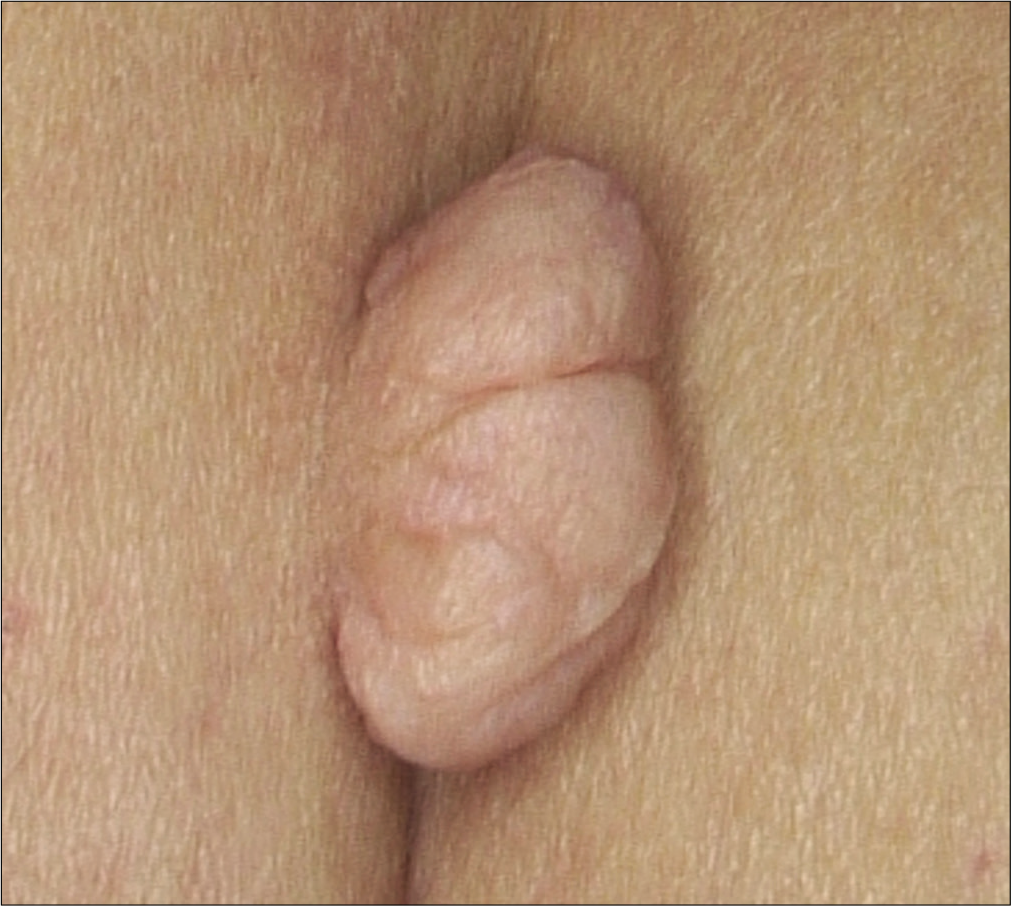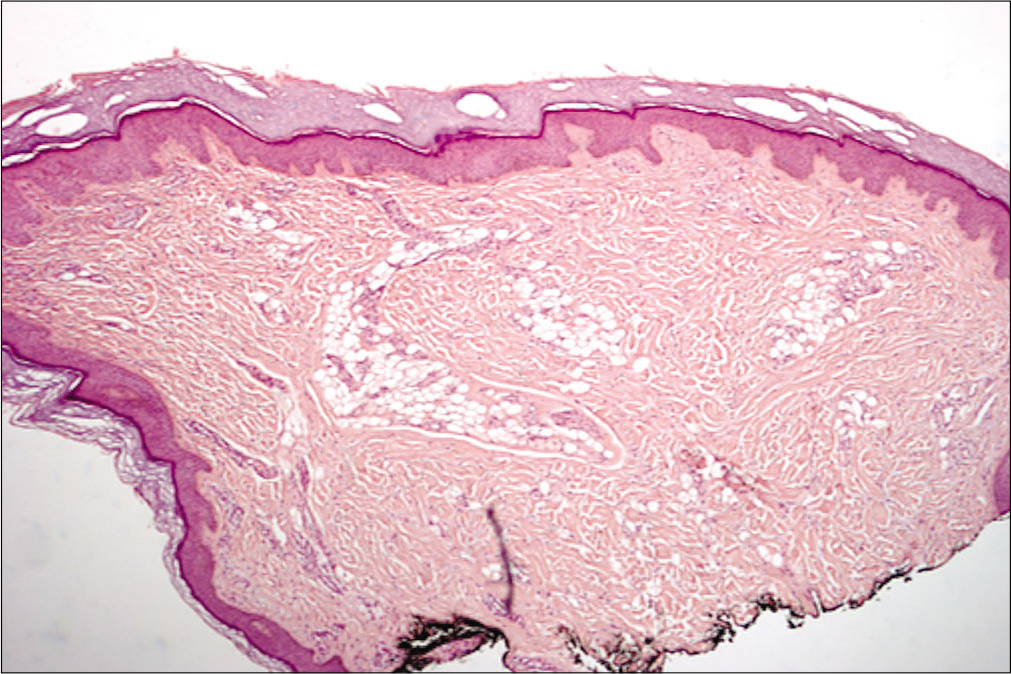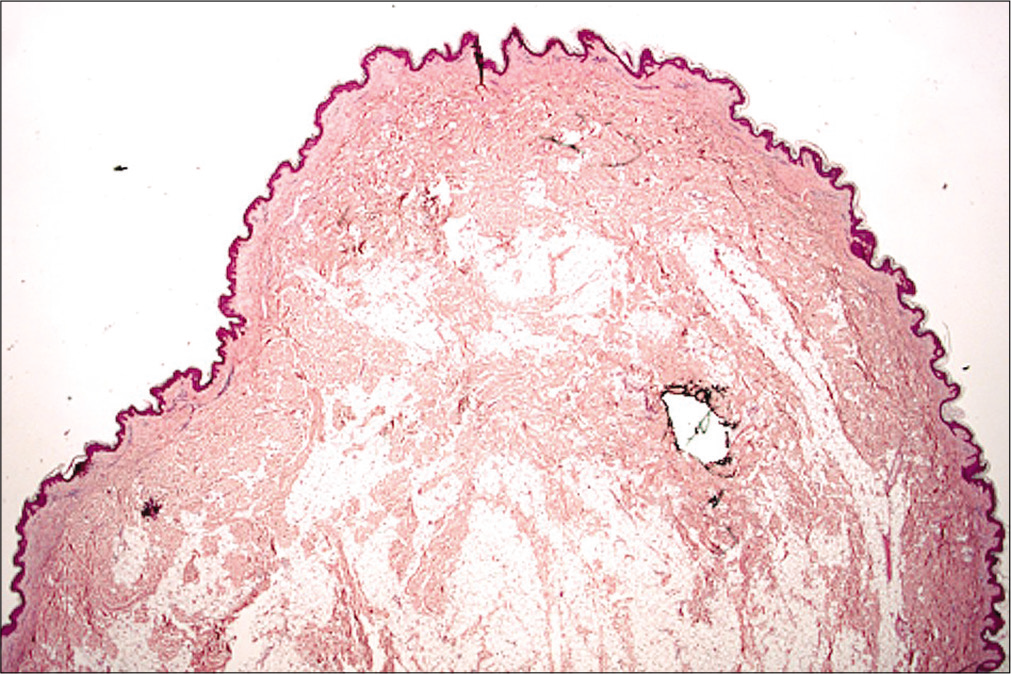Translate this page into:
Clinical, dermoscopic and histopathological features of solitary nevus lipomatosus cutaneous superficialis
Corresponding author: Dr. Carlotta Baraldi, Via Massarenti 1, 40138 Bologna, Italy. carlotta.baraldi3@unibo.it
-
Received: ,
Accepted: ,
How to cite this article: Baraldi C, Barisani A, Fanti PA, Patrizi A. Clinical, dermoscopic and histopathological features of solitary nevus lipomatosus cutaneous superficialis. Indian J Dermatol Venereol Leprol 2021;87:399-401.
Sir,
Nevus lipomatosus cutaneous superficialis is a rare congenital or acquired hamartoma, characterized by the presence of mature adipose tissue, localized within the dermis without continuity with the hypodermal adipose tissue. Two clinical variants of nevus lipomatosus cutaneous superficialis have been described: The multiple (the classic Hoffmann-Zurhelle form) and the solitary type. The classic type usually occurs at birth or during the first three decades of life and consists of multiple, soft skin-colored or yellowish papules or nodules, covered with smooth or wrinkled skin, sometimes with a cerebriform appearance.1 The lesions are mainly located in the lower back, buttocks and thighs. The classic form is usually unilateral and may have a linear or zosteriform configuration or can be grouped into a plaque. Although the classic type of nevus lipomatosus cutaneous superficialis is not typically associated with other malformations, there are reports of its coexistence with caféau-lait spots, solitary angiokeratoma of Fordyce and cherry angioma. On the other hand, the solitary form is expressed as a skin-colored, single nodule or papule without predilection for a specific age group or a typical location.2,3
We report here a series of 34 cases of solitary nevus lipomatosus cutaneous superficialis to assess the epidemiological, clinical, dermoscopic and pathological features. We identified 34 Caucasian patients with histopathologically confirmed solitary nevus lipomatosus cutaneous superficialis (dermatopathology service, University of Bologna) between January 2005 and December 2017. There were 22 (64.7%) women and 12 (35.3%) men, with a female to male ratio of 1.83:1. The average age at diagnosis was 51.8 years (range 3282 years). The legs were mostly affected across all genders (n = 10, 29.4%) followed by the trunk (n = 8, 23.5%), the buttocks (n = 7, 20.5%), the groin, the shoulders and the arms. We observed two different aspects of the solitary type. The first one was a skin-colored solitary pedunculated papule or nodule with a smooth skin-colored surface (n =19, 55.8%) [Figure 1a] and the second type was a skin-colored single, pedunculated nodule with a cerebriform, pinkish surface (n =15, 44.8%) [Figure 1b]. The size ranged from 0.3 mm to 2.5 mm. No associated comedones or dilated follicular ostia were observed. There was no association with any other skin lesion or malformation [Table 1]. All the lesions were examined by dermoscopy at different magnification. The main dermoscopic features of nevus lipomatosus cutaneous superficialis were pinkish background and linear whitish structures. At high magnification, the presence of linear-coiled and/or linear-loop-like vessels was evident. Dermoscopy of smooth-surfaced nevus lipomatosus cutaneous superficialis showed linear whitish structures with linear-coiled vessels and dermoscopy of nevus lipomatosus cutaneous superficialis with cerebriform surface showed brownish pigmented areas with irregularly distributed linear-coiled vessels and linear-loop-like vessels [Figures 2a and b]. Histopathology showed polypoid or papillomatous proliferations, hyperkeratosis of the epidermis and mature adipocytes embedded between the collagen bundles. A proliferation of dilated blood vessels with venular features, lined by regular single linear endothelium was evident in the upper dermis in all the nevus lipomatosus cutaneous superficialis. In the case of nevus lipomatosus cutaneous superficialis with a clinically smooth surface, adipocytes were present between the collagen bundles only in the reticular and adipocytes are present both in reticular and papillary dermis in the cerebriform type [Figures 3a and b].

- “Smooth surface” nevus lipomatosus cutaneous superficialis clinical presentation: skin-colored pedunculated nodule

- “Cerebriform surface” nevus lipomatosus cutaneous superficialis clinical presentation: pedunculated pinkish nodule with cerebriform surface

- “Smooth surface” nevus lipomatosus cutaneous superficialis’ dermoscopic features: linear-coiled vessels with whitish structures

- “Cerebriform” nevus lipomatosus cutaneous superficialis’ dermoscopic features: irregular distributed linear-coiled and linear-loop-like vessels and brownish pigmented areas

- Histological features of “smooth surface” nevus lipomatosus cutaneous superficialis (H and E, ×400)

- Histological features of “Cerebriform surface” nevus lipomatosus cutaneous superficialis (H and E,×200)
| Clinical features | Numbers of cases |
|---|---|
| Solitary type of nevus lipomatosus cutaneous superficialis | 34 |
| Multiple types of nevus lipomatosus cutaneous superficialis | 0 |
| Smooth surface | 19 |
| Distribution | |
| Legs | 7 |
| Trunk | 4 |
| Shoulders | 2 |
| Buttock | 3 |
| Arms | 0 |
| Groin | 3 |
| Size (cm) | |
| Average | 0.9 |
| Range | 0.3-2 |
| Cerebriform surface | 15 |
| Distribution | |
| Legs | 3 |
| Trunk | 4 |
| Shoulders | 1 |
| Buttock | 4 |
| Arms | 1 |
| Groin | 2 |
| Size (cm) | |
| Average | 1.2 |
| Range | 2.5 |
Our report of 34 cases of solitary nevus lipomatosus cutaneous superficialis is the largest series to date and could help to improve our familiarity with this rare hamartoma. In accordance with the published literature, we evidence that solitary form of nevus lipomatosus cutaneous superficialis is a tumor of adults, with a mean age of onset at 51.8 years and a female predominance.4Our study may give additional data about the clinical pattern of this rare hamartoma. We identified two clinical aspects of nevus lipomatosus cutaneous superficialis solitary type: One with a smooth surface and the other with the cerebriform surface, without any correlation with the distribution of the lesions. Indeed, in our study, any type of nevus lipomatosus cutaneous superficialis frequently arises on the legs. Histopathologically, the features of the single type nevus lipomatosus cutaneous superficialis are similar, but adipocytes are present only in the reticular dermis in the smooth-surfaced type; adipocytes are present both in reticular and papillary dermis in the cerebriform type. A proliferation of dilated blood vessels lined by regular single linear endothelium was evident in the upper dermis in all the nevus lipomatosus cutaneous superficialis. This is the first study to describe dermoscopic features of solitary nevus lipomatosus cutaneous superficialis. We found only one study in 2017, in which the authors describe the dermoscopic features of three classical nevus lipomatosus cutaneous superficialis but they did not identify any distinctive dermoscopic features of classical nevus lipomatosus cutaneous superficialis.5 In our opinion, the presence of linear-coiled or linear-loop-like vessels in the papillomatous solitary skin-colored lesion may be a clue for the dermoscopic diagnosis of a single nevus lipomatosus cutaneous superficialis.
Declaration of patient consent
The authors certify that they have obtained all appropriate patient consent.
Financial support and sponsorship
The authors did not receive any financial support or sponsorship.
Conflicts of interest
There are no conflicts of interest.
References
- UBER einennaevuslipomatodes cutaneous superficialis der linkenglutaalgegend. Arch Dermatol Syphilol. 1921;130:327-33.
- [CrossRef] [Google Scholar]
- Naevussuperficialislipomatosus. A clinicopathological report of twenty cases. Br J Dermatol1975;. ;93:121-33.
- [CrossRef] [Google Scholar]
- Giant nevus lipomatosussuperficialis with multiple folliculo sebaceous cystic hamartomas and dermoid cysts. J Eur Acad Dermatol Venereol. 2005;19:84-6.
- [CrossRef] [PubMed] [Google Scholar]
- Colocalization of lipedematous scalp and nevus lipomatosussuperficialis: A case report. J CutanPathol2007;. ;34:342-5.
- [CrossRef] [PubMed] [Google Scholar]
- Dermatoscopic evaluation of three cases of nevus lipomatosus cutaneous superficialis. Indian J Dermatol Venereol Leprol. 2017;83:383-6.
- [CrossRef] [PubMed] [Google Scholar]





